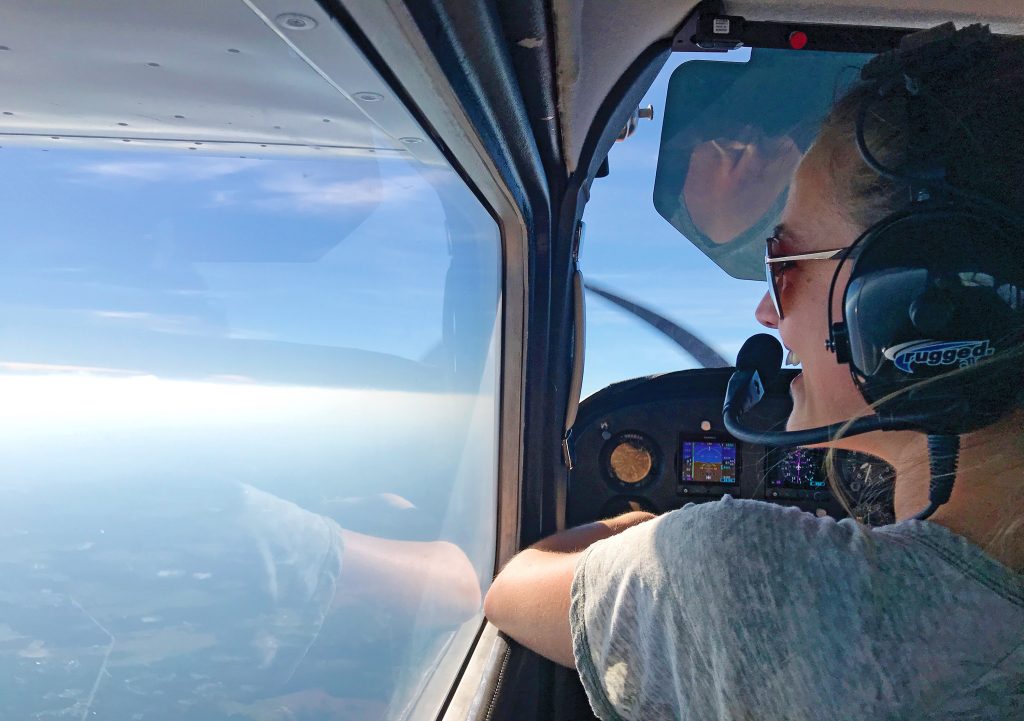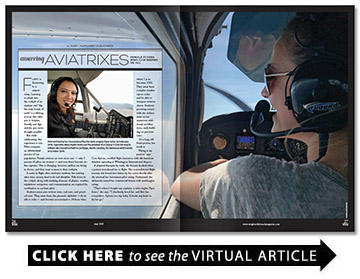Amazing Aviatrixes
Female flyers who can inspire us all.
BY Mary Margaret McEachern

Flight is fascinating. It is empowering. Learning to climb into the cockpit of an airplane and “slip the surly bonds of earth” is a lifelong process that takes you to heights, literally and figuratively, you never thought possible.
But while exhilarating, this experience is rare. Pilots comprise an infinitesimal percent of our population. Female aviators are even more rare — only 5 percent of pilots are women — and even fewer become airline captains. This is changing, however; airlines are hiring in droves, and they want women in their cockpits.
A career in flight often motivates students, but training takes time, money, hard work and discipline. Fifty hours in the cockpit, along with studying elements of physics, weather, regulations, navigation, and communication, are required for certification as a private pilot.
Students must pass written tests, oral tests, and practical tests. They must learn the phonetic alphabet — from alfa to zulu — and become accustomed to 24-hour time, where 1 p.m. becomes 1300. They must learn complex weather report codes and be able to interpret aviation charts. Students pursuing careers with the airlines must secure numerous additional certifications, each building on previous ones.
It’s a long, difficult process, but worth it.
“Flying is my passion,” says Cora Aytona, certified flight instructor with All-American Aviation operating at Wilmington International Airport.
A physical therapist by trade, she became hooked when a patient introduced her to flight. Her nontraditional flight journey was forced into hiatus by her career shortly after she attained her instrument pilot rating. Undaunted, she ultimately earned her commercial license with multiengine rating.
“That’s when I bought my airplane, a twin-engine Piper Aztec,” she says. “I absolutely loved her and flew her everywhere. Aytona was my baby. It broke my heart to let her go.”
Undeterred, Aytona recently earned her flight instructor’s certificate, displaying the flexibility and resilience necessary to become a competent pilot. She now passes on her knowledge and love of flying to eager students, many of them women.
She admits that flying seemed unnatural at first. Stalls scared her until “my patient instructor took the time to break each task down to its components.” A good instructor-student rapport is essential in training.
“I’ve learned that students have different learning styles and preferences,” Aytona says. “Instructors must adapt their teaching methods to match students’ individual needs. Articulating and simplifying tasks for someone who has never flown takes practice.”
Her students include Tiara Hendricks, a flight student who was inspired while in high school.
“I joined the Civil Air Patrol and learned to fly through their cadet program,” she says.
With the help of a flight school scholarship, Hendricks is closing in on her private pilot certificate.
Danielle Donovan has her private pilot, instrument and commercial ratings, and is taking flight instructor training at All-American.
“My mother is a flight attendant,” she says. “I’ve always loved aviation. Realizing I no longer wanted to study chemistry, I started flight training as a college sophomore in January 2019, and I went through it fast, passing my private pilot check ride that April.”
Donovan’s good friend, Mary Kuehn, worked as a flight attendant. On her first trip, the flight crew summoned her to the flight deck where she witnessed Greenland from 37,000 feet.
“With a view like that, how could you not want to become a pilot?” she says.
Donovan met Kuehn through aviation. They earned their commercial ratings the same day. They are now working together to earn their flight instructor certificates.
“[Mary] is one of my best friends,” Donovan says. “We have flown together to Sarasota and New York City. What a blast!”
Flight training is challenging. Would-be pilots must learn how to overcome various challenges and hurdles. Flying solo is daunting to most students but, once conquered, that hurdle engenders great confidence.
“I remember my first solo,” Donovan says. “I sat with my flight instructor and tried to talk to him the entire time allotted for my lesson so I wouldn’t have to go. I was so nervous! But he caught on quickly, telling me I could sit and talk all day, but I was soloing that day. So I did and, afterward, I felt like I could do anything.”
It doesn’t always work that way. Kuehn was low on confidence after completing her first solo.
“My biggest hurdle was my second solo,” Kuehn says. “I struggled with my landings. I had flown solo once. For some reason, I couldn’t [gather my wits] to go again. My instructors, recognizing my frustration with this roadblock, focused on other aspects of my training, allowing me to gain confidence in handling the airplane. When I was ready, I flew my second solo, and it went better than my first. Shortly afterward, I flew solo, cross-country, and was able to quickly complete my training.”
Solo cross-country flight proved Hendricks’ greatest hurdle.
“I hesitated to fly out of the pattern by myself,” she says. “It was windy, gusting to 26 knots. I wanted to wait. I almost did. I’m so glad I didn’t. That flight sealed my self-confidence.”
Hendricks also recalls her first night flight: “The first time I flew over the ocean at night, the disorientation I felt in complete darkness taught me an important lesson — to trust my airplane’s instruments.”
Trust the instruments, and the instructor who knew she could handle it.
“Trust the process,” she says. “Be confident. You may be afraid. You may hesitate. That’s normal. If an instructor thinks you’re ready, then you’re ready. You’ve got this.”
Donovan had her own challenges.
“I struggled with crosswind landings,” she says. “I dreaded them, but with time and practice, I gained the confidence I needed to perfect them. Experience is everything in flying; it’s what makes it so fun.”
Financing flight school can seem impossible. It costs up to $10,000 to obtain a private pilot’s license. The price soars for a commercial license: nearly $64,000 when starting with a private license and $81,000 without. But the increased demand for female aviators has many airlines offering to pay training costs. Several organizations, such as Women in Aviation International, AOPA, the Ninety-Niners, and EAA, offer generous scholarship programs.
“I was grateful to receive an EAA scholarship that covered my private pilot training,” Hendricks says.
Donovan’s mother kickstarted her training.
“She has been my backbone and I couldn’t do this without her,” Donovan says. “She covered my private and instrument training.”
Further training is up to Donovan.
“I worked fulltime at the airport while also attending college,” she says. “I borrowed additional money to cover my training, and, I’m okay with that, because I am investing in my future.”
Aviation offers countless opportunities. Some flight students continue toward their original goal; others refine their goals as they discover their options.
“I could become a fighter pilot,” Hendricks says. “I could fly for the airlines. I could ferry wealthy individuals [in private jets]. I could fly just to fly!”
The aviation community comprises instructors, pilots and support crews, male and female.
“Everyone, genuinely, wants everyone to succeed,” Donovan says. “The people I have met in my training are among the finest I’ve known, and they only make me love what we do even more. It’s no secret that there are [relatively] few women in aviation, but that is changing. I feel this community to be the most empowering place a woman can find herself. Flying is awesome, and it’s even better with friends.”
Kuehn credits her inspiration to some female flight attendant friends.
“My flight training experience has been amazing, thanks to great instructors and students at my flight school,” she says. “It’s so encouraging, to have everyone helping others achieve dreams of taking to the skies, together.”
Aytona agrees. “If you work hard and strive for excellence, you will succeed, regardless of gender.”
